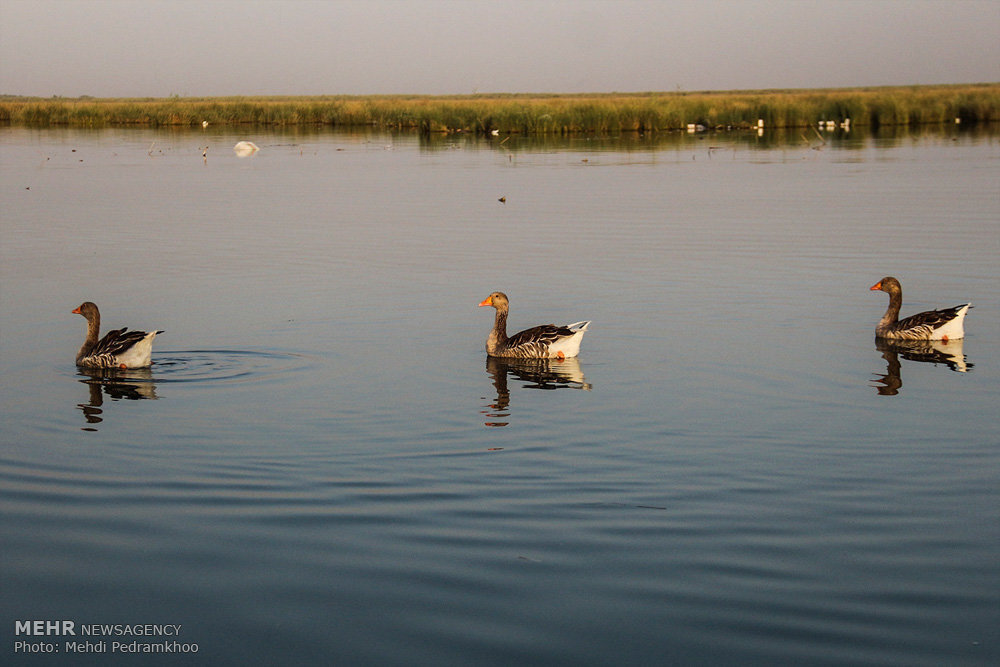Wetlands facing debilitation

TEHRAN – Satellite monitoring of 13 main lakes and wetlands of the country shows that the water volume of 10 of them has remained constant or decreased over the past [Iranian calendar] year (March 2019-March 2020).
Lakes and natural wetlands are among the most important ecosystems on the planet that play a vital role in the survival of various plant and animal species. Due to this issue, the Iranian Space Agency periodically and regularly monitors the important wetlands and lakes.
In this regard, 13 lakes and wetlands in the country were monitored in the Iranian calendar month of Mehr (September 23- October 22), which includes Alagol, Ajigol, Almagol and Gomishan wetlands in Golestan province, Choghakhor wetland in Chaharmahal and Bakhtiari province, Parishan lakes, Arjan, Tashk, Bakhtegan and Maharloo in Fars province, Ghouri Gol wetland in East Azerbaijan, Lake Urmia in East and West Azerbaijan provinces and Hamouns in Sistan and Baluchestan province.
The data shows that lakes and wetlands such as Aji Gol, Almagol, Choghakhor, Tashk, and Maharloo wetlands and Urmia lake shrank during the aforesaid period compared to the same period last year, water. Also, some wetlands completely dried up due to the decreased rainfall during summer.
The highest decrease in water level is related to the Choghakhor wetland in Chaharmahal and Bakhtiari province.
Also, Bakhtegan wetland, Parishan, and Arjan lakes have completely dried up, while Ajigol and Almagol wetlands are drying up. Unlike these lakes, the water level of Alagol, Gomishan, and Ghouri Gol lakes increased.
The water surface of Lake Urmia was about 3,060 square kilometers, which, compared to the same period a year ago, dropped by 2 percent (reported 3,120 square kilometers).
Earlier in November, Ali Arvahi, the director of the Conservation of Iranian Wetlands Project, said that a comprehensive management program is now being implemented for 18 wetlands of the country.
The comprehensive program for the protection of Parishan, Shadegan, Urmia, Qara Gheshlagh, Qourigol, Miqan, Choghakhor, Zarivar, Hamoon, Bakhtegan, Alagol, Gavkhoni, Noruzlu, Soldoz, Kani Barazan, Haray Minab, Ne’or, and Gandoman wetlands has been approved and is being implemented, he added.
The project aims to focus on better management of wetlands in accordance with climate change, improving the management of natural resources, and emphasizing the role of public participation and raising awareness, Arvahi stated.
In Iran, 141 wetlands with ecological value with an area of over 3 million hectares have been identified, of which 25 wetlands are designated as wetlands of international importance (registered in the Ramsar Convention) covering more than 1.4 million hectares and four sites are biosphere reserves.
Of Iran’s 25 Ramsar sites about one-third are under pressure or in critical condition.
Chief of the Department of Environment (DOE) Issa Kalantari has said in order to restore wetlands in the country a budget of 600 trillion rials (nearly $14 billion) is required.
Wetlands are important features in landscape
Wetlands are ecosystems saturated with water, either seasonally or permanently. They store water and ensure its quality, providing resilience against drought. They play a central role in sustainable development by supplying all our freshwater.
Natural wetlands are a variety of habitats such as rivers, lakes, coastlines, mangrove forests, and even coral reefs. An immense variety of species of microbes, plants, insects, amphibians, reptiles, birds, fish, and mammals can be part of a wetland ecosystem.
They are among the most productive ecosystems in the world, comparable to rain forests and coral reefs.
The functions of a wetland and the values of these functions to humans depend on a complex set of relationships between the wetland and the other ecosystems in the watershed. A watershed is a geographic area in which water, sediments, and dissolved materials drain from higher elevations to a common low-lying outlet or basin a point on a larger stream, lake, underlying aquifer, or estuary.
Wetlands play an integral role in the ecology of the watershed. The combination of shallow water, high levels of nutrients and primary productivity is ideal for the development of organisms that form the base of the food web and feed many species of fish, amphibians, shellfish, and insects. Many species of birds and mammals rely on wetlands for food, water, and shelter, especially during migration and breeding.
About 20,000 different species of fish found worldwide live in freshwater (natural wetlands).
Wetlands' microbes, plants, and wildlife are part of global cycles for water, nitrogen, and sulfur. Scientists now know that atmospheric maintenance may be an additional wetlands function. Wetlands store carbon within their plant communities and soil instead of releasing it to the atmosphere as carbon dioxide. Thus wetlands help to moderate global climate conditions.
FB/MG
